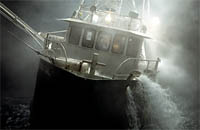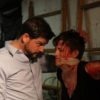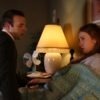
DVDs: A Master Class in Movie Making
Written by Peter Bohush | Posted by: Anonymous
Watching a 90-minute movie has become a four-hour experience for me now that I have a DVD player. First I watch the movie. Then I turn on the director’s commentary track and watch the whole thing again. And finally I pour through every special feature on the disk: the documentary, deleted scenes, storyboards, production notes. No wonder I never get to sleep before 2 am.
I recall my film school days, when a projectionist ran the epic battle scene from Barry Lyndon. Twice. We had to storyboard every shot in that battle scene while seeing it fly by only two times. And forget about knowing what Stanley Kubrick had on his mind when he lit a scene with hundreds of candles. His voice was absent from the scratchy print we had to deal with.
Today, many DVDs are like a master class with the film’s director, producer or stars. You can freeze frames and watch things over and over again. It’s a priceless knowledge transfer that costs nothing beyond the normal purchase or rental price. The technology has given professional and aspiring filmmakers a look into productions that was rarely available before.
Here are a few of my favorites (in alphabetical order.)
"Bowfinger"
Director – Frank Oz
Frank Oz takes the viewer on one of the most insightful journeys into the mind and experiences of a motion picture director. His commentary track dissects the film in minute detail. At one point, he explains how an entire set had to be recreated months after principal photography in order to get one shot of Steve Martin getting his money box out of hiding. Oz felt it was important to help the audience better understand the story and Martin’s character. Inserting the shot results in a seamless sequence of shots that leaves the viewer all the more amazed at Oz’s filmmaking abilities. The commentary on how they shot Eddie Murphy running through cars across the Hollywood Freeway is something you’ll never learn in film school.
"Gladiator"
Director – Ridley Scott
An entire disk of extras and special features is included along with the director’s commentary on the main movie disc. The "making of" short includes interviews with Russell Crowe, Richard Harris and other cast members; insights into the creation of the physical and computer-generated sets; prop making; costumes and make-up for 2,000 actors, and more. The entire set of the film’s storyboards is on the disc, as are about a dozen deleted scenes. The DVD set is as much as spectacle as the film’s story!
"The Man Who Would Be King"
Director – John Huston
Huston isn’t around to provide commentary on his epic masterpiece. But an old documentary exists that pulls back the curtain on the movie magic. The majestic mountain city that Michael Caine and Sean Connery assume as their kingdom is revealed in its flats and facades. Huston provides anecdotes and production notes on getting his lifelong dream to the screen. Imagine going half way around the world to shoot a film and depending on luck to find the perfect non-actor to play a major character in the film. That’s the kind of stuff that made Huston a legend and his movies legendary.
"The Perfect Storm"
Director – Wolfgang Petersen
Viewers marveled at the realistic ocean storm effects. In the DVD’s special feature, see the actors on the massive set in front of the blue screen that would later become the stormy Atlantic. The documentary shows numerous before and after shots of the actors on the soundstage boat and what it looked like in the finished film. You will be even more amazed at the film when you see how they did it, and how important technology is in today’s filmmaking. Petersen himself admits this film couldn’t have been made even five years ago. Petersen’s commentary includes interesting discussions of the locations used in the film. And the disc includes some beautiful storyboard paintings done to provide the designers with a sense of what the film should look like.
"Pi"
Director – Darren Aronofsky
The director’s commentary track on this low-budget cult classic provides a glimpse of what a filmmaker with extremely limited resources must do to achieve his vision. In addition to offering some explanations about the story itself, the DVD offers deleted scenes and behind the scenes look at the sets and production design.
"Run Lola Run"
Director – Tom Tykwer
Not exactly a filmmaking manual, but the audio tracks give an aspiring filmmaker an idea of how their film might play in another country. Watch this film first with the German language soundtrack and English subtitles. Then run it again with the English dubbing and try not to scream at the wimpy voice they chose for Lola’s boyfriend — and how they rewrote all the swear words to things like "gosh darn it!" You can also run it in French for a feeling of "Je ne se quois."
"Running Time"
Director – Josh Becker
An homage to Hitchcock’s film "Rope," "Running Time" runs in real time as a man gets out of prison and immediately embarks on an armed robbery with his buddy. Made to look like one long take, the director and star chat in the commentary track about the filmmaking experience. There are only nine cuts in the film, all of them seamless, with nine-minute takes for each sequence. As Josh and Bruce chat, you’ll learn some neat filmmaking tricks like putting a huge gel filter over the windshield of the truck when the camera was shooting from inside it; and how to fake changing a flat tire in 30 seconds without cutting away to another shot. This commentary is like being in the screening room with the crew while they reminisced about making the film. That’s as good as it gets if you love making movies.
"The Sixth Sense"
Director – M. Night Shyamalan
There’s a reason this is one of the highest grossing films of all time. The attention to detail Shyamalan paid from the script to the production design to the editing is shown in the director’s track and numerous special features. Knowing the rules he imposed within the script, and how he used the color red in the film provide an incentive to watch it again, just to see how perfect it all is. The director explains how heartbreaking it was to cut a deleted sequence, but how it improved the final version. Watching the beautiful scenes makes you feel his pain. And seeing his homemade video should give any aspiring filmmaker a boost. If a dorky teenager like him, who made such a piece of crap like that, can end up writing and directing "The Sixth Sense," then you can be great someday, too!
"Time Code"
Director – Mike Figgis
A breakthrough movie, shot in one take with four cameras simultaneously following four storylines, which all appear together on the screen. The released version (take 15) is on the disc, as well as the very first take with Figgis’ commentary. What an amazing experience to watch a complete outtake of a major motion picture with the director’s narration. Take 1 would be assumed to be the roughest of the two weeks of filming, since the script and dialog was largely improvised. Here one can see the results of Figgis’ original direction to the actors, and hear him talk about how the story changed over time to the final version.
In keeping with the latest moviemaking trend, Peter Bohush cut out a beautiful sequence from his movie 'Geezers' just so he could include it in the deleted scenes section, and added a commentary track with a story of how a rowdy group of seminarians nearly disrupted shooting on the T. Look for the 'Geezers: 2001 Special Edition' soon at www.WriterDirector.com.










